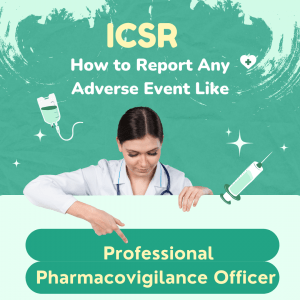Pharmacovigilance PDF Materials
Original price was: 299 $.49 $Current price is: 49 $.
+ 77 PDFs Topics are:
- Signal Detection.
- FDA & EMA Guidelines.
- Post-Marketing Surveillance or drug safety monitoring
- Drug Cycle
- Pharmaceutical Drug Commercialization
- Clinical Trials Explanation
- Pharmacovigilance Foundations Career Support Reports
Description
77 Pharmacovigilance PDF Materials Details.
Pharmacovigilance PDF Materials are online learning tools that help healthcare professionals identify adverse drug reactions ADRs from pharmaceutical products. They also help keep patient safety by monitoring the benefit-risk of these products. Pharmacovigilance PDF materials can be found on the Pharmacovigilance Programme of the World Health Organization (WHO) website.
These materials include information on after-marketing surveillance and the life cycle of drug production. Pharmacovigilance PDF materials are designed for HCPs who want to learn more about Pharmacovigilance and how to identify and report adverse drug reactions.
Pharmacovigilance is the science and activity concerned with detecting, assessing, understanding, and preventing adverse effects or other drug-related problems. It includes the pharmacovigilance study material pdf of drug safety in all patient populations across all settings where drugs are used.
Its activities ensure that patients receive the safest and most effective medicines possible.
To detect and assess adverse drug reactions (ADRs), pharmacovigilance relies on HCPs and members of the public expedited reporting of suspected ADRs. These reports are followed up by detailed analysis to confirm whether an ADR has occurred and, if so, to characterize its features and establish any risk factors. This information is used to refine our understanding of how
What are the benefits of learning from pharmacovigilance PDF?
Pharmacovigilance is the science and activity related to the detection till reaching prevention of adverse effects of medicines.
There are many benefits of learning from pharmacovigilance PDFs. One benefit is that it helps to identify risks for certain adverse events. For example, if a patient has a history of heart problems, they may be at risk for a life-threatening event if they take a certain medication.
By understanding these risks, pharmacists and other healthcare professionals can make more informed decisions about which medications to prescribe. Additionally, learning from pharmacovigilance PDFs can help to improve patient care.
For example, if a patient experiences an adverse event after taking a new medication, the PDF can help prevent future events by informing prescribing decisions. Finally, studying pharmacovigilance PDFs can also help improve patient safety by identifying areas where more research is needed. In sum, there are many benefits to learning from pharmacovigilance PDFs.
What are the four main components of pharmacovigilance?
Pharmacovigilance is the safety data of drug safety. It involves assessing, understanding, and preventing safety information on human drugs.
Pharmacovigilance aims to ensure that drugs are as safe and effective as possible.
Pharmacovigilance activities can be divided into four main components: spontaneous reporting, periodic safety update reports, risk plans, and pharmacovigilance training.
Periodic safety reports are regular reports on the safety of a particular drug submitted to regulatory authorities (RAs).
Risk management plans are developed to minimize the risks associated with a particular drug. Pharmacovigilance training is essential for all healthcare professionals who prescribe, dispense or administer drugs.
By understanding the importance of these four components of pharmacovigilance, we can help to ensure that drugs are safe and effective for all patients.
What is GVP modules in pharmacovigilance?
Pharmacovigilance is monitoring the safety of drug safety.
These modules provide safety information on specific drugs or classes of drugs. They are used to assess a drug’s safety and determine whether it should be removed from the market.
The most common module is the GVP module, which is used to assess a drug’s safety and determine whether it should be removed from the market. The GVP module is important because it helps ensure that a drug is safe for humans.
How many modules are there in pharmacovigilance?
There are eight modules in pharmacovigilance. They are:
1) Company Organization and Functions;
2) Antibody Technology and Development;
3) Preclinical Studies;
4) Clinical Trial;
5) Postmarketing Studies
6) Clinical Safety Data Management;
7) Regulatory Affairs; and
8) Pharmacovigilance Systems to report ICSR
Each module covers a different aspect of pharmacovigilance and is designed to provide students with a comprehensive understanding of the field.
Experts teach the modules in the field, and students have the opportunity to gain hands-on experience through case studies and group work. By the end of the course, students will have a thorough knowledge of pharmacovigilance and be able to apply it to real-world situations.
What are the 4 subsets of ICH?
The International Council for Harmonisation of Technical Requirements for Pharmaceuticals for Human Use (ICH) is an internationally recognized body that provides guidance on pharmaceuticals’ quality, safety, and efficacy.
ICH was established in 1990 with representatives from RAs, the pharmaceutical industry, and academia.
The goal of ICH is to promote the harmonization of regulatory requirements for pharmaceuticals globally, aiming to improve patient safety and ensure that new and innovative treatments are available to patients worldwide.
The ICH includes four major subsets: Quality, Safety, Efficacy, and Clinical.
Each subset contains several guidelines that provide specific recommendations on drug development and regulation aspects.
Together, these guidelines provide a comprehensive framework for developing and regulating pharmaceuticals.
By promoting harmonization across jurisdictions, ICH contributes to a more efficient and effective global drug development process. This ultimately benefits patients by making new treatments available more quickly and reducing the risk of adverse reaction.
What are types of pharmacovigilance?
2 reviews for Pharmacovigilance PDF Materials
You must be logged in to post a review.



Mohamed mahmoud saber –
Dr pH
Yomna –
That’s very good